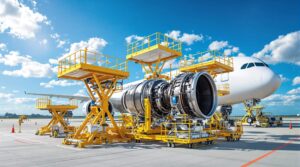Firstly, let’s dissect the purpose of flaps. These are movable surfaces on the wings of an aircraft, positioned towards the trailing edge. Unlike the static wings, flaps are dynamic components that play a pivotal role during various phases of flight.
During takeoff, when every ounce of lift matters, flaps come into play. By extending these flaps downwards, the wing’s surface area increases. This amplifies the lift generated, allowing the aircraft to gracefully ascend into the sky even at lower speeds. In aviation lingo, this process is referred to as flap deflection.
As the aircraft climbs to cruising altitude, flaps retract, reducing the overall drag. This is crucial for fuel efficiency and maintaining optimal speed during the journey. Essentially, flaps act as the aircraft’s adjustable wings, adapting to the demands of each flight phase.
Now, let’s delve into the mechanics of how do flaps work. The engineering brilliance lies in the articulation of these surfaces. Pilots, with precision control, can manipulate flaps to different positions. There are several settings, each serving a specific purpose.
For instance, the takeoff setting extends the flaps to their maximum, optimizing lift for departure. During landing, flaps are again deployed, enhancing the wing’s surface area. This increased lift, coupled with decreased speed, facilitates a smooth descent.
It’s fascinating to note that flaps aren’t just about lift; they also influence the aircraft’s stability and control. Pilots judiciously adjust flap settings based on factors like weather conditions, weight, and desired performance.
Flaps on aircraft and takeoff procedures
When it comes to aircraft takeoff procedures, the role of flaps cannot be overstated. These aerodynamic surfaces play a crucial role in optimizing the aircraft’s performance during takeoff, ensuring a safe and efficient departure from the runway.
The flaps are movable sections on the trailing edge of the wings. During takeoff, they serve to increase the lift generated by the wings, allowing the aircraft to achieve the necessary altitude for a smooth departure. The deployment of flaps alters the aerodynamic characteristics of the wing, effectively enhancing its ability to generate lift at lower speeds.
One of the key takeoff procedures involves the careful selection of the appropriate flap settings based on factors such as aircraft weight, runway length, and ambient weather conditions. Pilots must consider these variables to determine the optimal configuration that maximizes lift while minimizing drag.
Flaps typically have multiple settings, ranging from 0 to full deployment. The choice of flap settings depends on the specific requirements of the takeoff, with pilots consulting performance charts and manuals to make informed decisions. As the aircraft accelerates down the runway, the pilot incrementally adjusts the flap settings to optimize lift and control.
During the takeoff roll, the initial flap setting is often a lower degree, gradually increasing as the aircraft gains speed. This staged deployment minimizes drag during the initial acceleration phase while gradually enhancing lift. Pilots must also be vigilant about retracting the flaps once a safe and sufficient altitude is reached, as extended flaps can lead to increased drag and reduced fuel efficiency.
In addition to their role in lift augmentation, flaps also contribute to improved controllability during takeoff. By altering the wing’s camber, flaps assist in maintaining a stable and controlled ascent. This is particularly critical during the early stages of takeoff when the aircraft is transitioning from ground to flight.
It’s important to note that the specific procedures for flap deployment may vary between different aircraft models. Manufacturers provide detailed guidelines, and pilots undergo extensive training to master the nuances of flap usage during takeoff.
Why are flaps used for landing an aircraft
When an aircraft prepares for approach and descent during landing, the role of flaps becomes crucial in ensuring a safe and controlled landing experience. Flaps are specialized aerodynamic surfaces on the wings of an aircraft that can be extended or retracted as needed. Their primary function during the landing phase is to modify the wing’s shape, thereby influencing key aerodynamic factors like stability, lift, and drag.
As the aircraft begins its approach to the runway, pilots deploy flaps to increase the wing’s surface area. This extension serves a dual purpose: it enhances the overall lift generated by the wings and increases drag. The augmented lift is crucial during the descent phase as it allows for a steeper approach angle without compromising the safety margins. Additionally, the increased drag helps to reduce the aircraft’s speed, providing the necessary control for a smooth and precise landing.
The manipulation of flaps plays a pivotal role in achieving the optimal balance of lift and drag during the landing process. As the flaps extend, they alter the wing’s aerodynamic characteristics, effectively creating more lift while simultaneously inducing drag. This delicate equilibrium is essential for a controlled descent and a well-paced approach to the runway.
Furthermore, flaps contribute significantly to the overall stability of the aircraft during the landing phase. By increasing the wing’s surface area, flaps help maintain a steady and predictable flight path, mitigating the impact of external factors such as gusty winds. The added stability is particularly crucial during the critical moments of approach and descent, where precise control is imperative for a safe touchdown.
In essence, the strategic use of flaps is a dynamic dance between lift, drag, and stability, orchestrated by skilled pilots to ensure a seamless landing experience. By harnessing the aerodynamic benefits of flaps, aircraft can navigate the delicate balance between descending gracefully towards the runway and maintaining the necessary control for a safe and controlled landing.
Retracting flaps after takeoff and climb out procedures
As an aircraft initiates its ascent into the sky, the intricate dance between climb and velocity unfolds with precision. Pilots meticulously retract flaps after takeoff, a crucial step in optimizing the aircraft’s performance during the initial stages of flight. This procedure marks the transition from a high-lift configuration, suitable for takeoff, to a more streamlined profile that enhances efficiency during the climb.
With the flaps now snugly tucked away, the aircraft adjusts its attitude, pitching upward to gain altitude. The climb phase is characterized by a delicate balance of forces—drag, lift, and the relentless pursuit of optimal velocity. Pilots keenly monitor these factors, seeking the sweet spot that maximizes the rate of climb while minimizing energy expenditure.
The reduction in drag achieved by retracting flaps plays a pivotal role in this performance optimization. The streamlined configuration reduces the resistance encountered by the aircraft, allowing it to cut through the air with greater ease. As velocity becomes the focal point, the aircraft strives to maintain an optimal speed that strikes a harmonious chord between climbing efficiently and overcoming the persistent force of drag.
Simultaneously, the wings continue to harness the fundamental principle of lift, essential for defying gravity and propelling the aircraft skyward. The interplay between lift and drag is a constant, dynamic negotiation as the aircraft ascends through the atmosphere. The retracting flaps signify a commitment to minimizing induced drag while preserving the essential force of lift that sustains the climb.
However, the ascent into the heavens is not always a serene journey. Atmospheric conditions introduce an unpredictable element—turbulence. As the aircraft climbs, it may encounter pockets of disturbed air that challenge the delicate equilibrium maintained by the pilot. Turbulence becomes a test of the aircraft’s structural integrity, requiring both robust engineering and the pilot’s skillful management of control surfaces to navigate through the unsteady atmosphere.
In essence, the retraction of flaps after takeoff marks the commencement of a carefully orchestrated symphony. The aircraft, now unburdened by the extended flaps, embarks on a dance with the forces of climb, velocity, drag, lift, and the capricious nature of turbulence. This aerial ballet, guided by the hands of skilled aviators, propels the flying machine towards its designated altitude, a testament to the seamless integration of technology, physics, and human expertise.






